|
|
|
Sort Order |
|
|
|
Items / Page
|
|
|
|
|
|
|
| Srl | Item |
| 1 |
ID:
134003
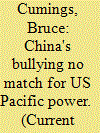

|
|
|
|
|
| Publication |
2014.
|
| Summary/Abstract |
Readers of a certain age will recall the cadences of the satirist Tom Lehrer's "National Brotherhood Week," and perhaps also his indelible punch line: "And everybody hates the Jews" (though fortunately that is not an East Asian problem). You may notice that my adaptation of the ditty leaves out the United States, which made war in East Asia from 1941 to 1975, and during those wars hated "the Japs," "Red China," Korean commies, and the Viet Cong. All such hatreds were nicely reciprocated by East Asians, and, by the 1980s, the Americans had even contrived to be hated by the South Koreans.
|
|
|
|
|
|
|
|
|
|
|
|
|
|
|
|
| 2 |
ID:
133997
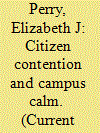

|
|
|
|
|
| Publication |
2014.
|
| Summary/Abstract |
Civil society in contemporary China presents a perplexing paradox. Despite the brutal suppression of the 1989 Tiananmen uprising, social contention and associational activism swelled over the ensuing years. One might have expected the ruthless June Fourth repression of the massive student movement to have deterred subsequent dissent, but in fact the frequency of protest has steadily escalated in the past 25 years. Moreover, China today is host to countless grassroots (as well as government-sponsored) nongovernmental organizations (NGOs), foundations, and charities-not to mention a vibrant sphere of online public debate. In contrast to 1989, a nascent civil society can now be said to exist.
|
|
|
|
|
|
|
|
|
|
|
|
|
|
|
|
| 3 |
ID:
133998


|
|
|
|
|
| Publication |
2014.
|
| Summary/Abstract |
The world does not lack for trouble spots in 2014, when tragedies in Ukraine and the Middle East have dominated Western headlines. Less prominent in recent months has been the potential for clashes between China and its neighbors in the South and East China Seas. Yet this is a region where a large proportion of the world's population lives and the world's second and third biggest economies (China and Japan) are located, with the single largest economy (the United States) also exercising a powerful regional role. A clash here would have global repercussions.
|
|
|
|
|
|
|
|
|
|
|
|
|
|
|
|
| 4 |
ID:
134000
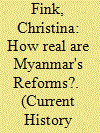

|
|
|
|
|
| Publication |
2014.
|
| Summary/Abstract |
Since 2011, Myanmar has undergone a period of extraordinary political and economic change. The government has partially democratized, reengaged with the international community, and sought to improve ordinary citizens' quality of life. Yet for all these achievements, the transition process has been uneven. The military has maintained a large degree of power and influence, and divisions persist within the government regarding the extent to which political openness and public accountability should be institutionalized. Further reforms are likely to be contentious.
|
|
|
|
|
|
|
|
|
|
|
|
|
|
|
|
| 5 |
ID:
133999
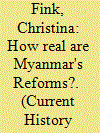

|
|
|
| 6 |
ID:
134002
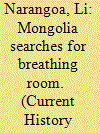

|
|
|
|
|
| Publication |
2014.
|
| Summary/Abstract |
Sandwiched between Russia and China, Mongolia has long been dominated by the two giants that surround it. Indeed, for most of the past four centuries, the choice between its neighbors' influence has been an either-or proposition. With the brief exception of Japan's intervention on the Asian mainland during World War II, there were no external powers that Mongolia could conceivably approach to soften the harsh Russia-China alternative. In recent years, though, the situation has changed dramatically. For the first time in modern history, Mongolia has asserted its sovereign right to engage in numerous bilateral relationships outside the old Russia-China dynamic, focusing on both strategic affairs and economics. In 2013 alone, the nation signed 63 bilateral and international agreements.
|
|
|
|
|
|
|
|
|
|
|
|
|
|
|
|
| 7 |
ID:
134001
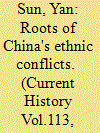

|
|
|
|
|
| Publication |
2014.
|
| Summary/Abstract |
A surge of ethnic violence in China in recent years has revealed growing social tensions in a country beset by developmental strains, with a political system lagging behind epic economic change. In the first half of 2014 alone, there were at least five instances of what the state defines as terrorism associated with Xinjiang, the Muslim borderland in the west. A May attack at a vegetable market in Urumqi, Xinjiang's capital, killed 43 people. In August, clashes in Xinjiang left nearly 100 dead. And the spread of violence to other provinces-notably in Beijing's Tiananmen Square last October and at the rail station in the southwestern city of Kunming this March- has brought home the reality of ethnic tensions to Chinese citizens outside sensitive minority regions.
|
|
|
|
|
|
|
|
|
|
|
|
|
|
|
|
|
|
|
|
|